key PEUGEOT 2008 2013.5 Owner's Manual
[x] Cancel search | Manufacturer: PEUGEOT, Model Year: 2013.5, Model line: 2008, Model: PEUGEOT 2008 2013.5Pages: 336, PDF Size: 9.23 MB
Page 95 of 336
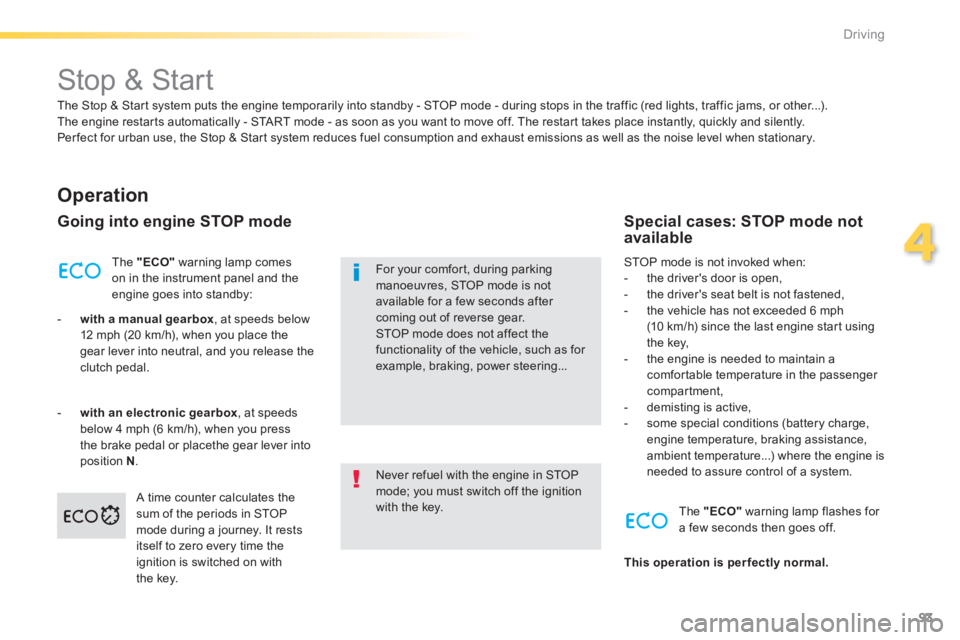
93
4
Driving
Stop & Start
Operation
Going into engine STOP mode
The "ECO" warning lamp comes on in the instrument panel and the engine goes into standby:
- with a manual gearbox , at speeds below 12 mph (20 km/h), when you place the gear lever into neutral, and you release the clutch pedal.
- with an electronic gearbox , at speeds below 4 mph (6 km/h), when you press the brake pedal or placethe gear lever into position N . Never refuel with the engine in STOP mode; you must switch off the ignition with the key.
For your comfort, during parking manoeuvres, STOP mode is not available for a few seconds after coming out of reverse gear. STOP mode does not affect the functionality of the vehicle, such as for example, braking, power steering...
Special cases: STOP mode not available
STOP mode is not invoked when: - the driver's door is open, - the driver's seat belt is not fastened, - the vehicle has not exceeded 6 mph (10 km/h) since the last engine start using the key, - the engine is needed to maintain a comfortable temperature in the passenger compartment, - demisting is active, - some special conditions (battery charge, engine temperature, braking assistance, ambient temperature...) where the engine is needed to assure control of a system.
A time counter calculates the sum of the periods in STOP mode during a journey. It rests itself to zero every time the ignition is switched on with the key.
The "ECO" warning lamp flashes for a few seconds then goes off.
This operation is perfectly normal.
The Stop & Start system puts the engine temporarily into standby - STOP mode - during stops in the traffic (red lights, traffic jams, or other...). The engine restarts automatically - START mode - as soon as you want to move off. The restart takes place instantly, quickly and silently. Per fect for urban use, the Stop & Start system reduces fuel consumption and exhaust emissions as well as the noise level when stationary.
Page 97 of 336
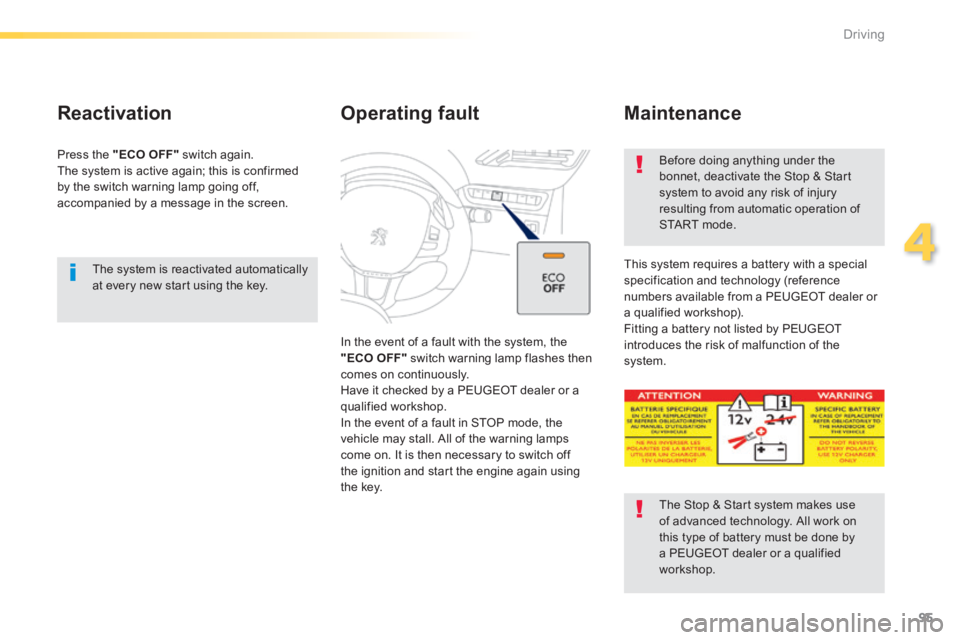
95
4
Driving
The system is reactivated automatically at every new start using the key.
Reactivation
Press the "ECO OFF" switch again. The system is active again; this is confirmed by the switch warning lamp going off, accompanied by a message in the screen.
Operating fault
In the event of a fault with the system, the "ECO OFF" switch warning lamp flashes then comes on continuously. Have it checked by a PEUGEOT dealer or a qualified workshop. In the event of a fault in STOP mode, the
vehicle may stall. All of the warning lamps come on. It is then necessary to switch off the ignition and start the engine again using the key.
Before doing anything under the bonnet, deactivate the Stop & Start system to avoid any risk of injury resulting from automatic operation of START mode.
This system requires a battery with a special specification and technology (reference numbers available from a PEUGEOT dealer or a qualified workshop). Fitting a battery not listed by PEUGEOT introduces the risk of malfunction of the system.
Maintenance
The Stop & Start system makes use of advanced technology. All work on this type of battery must be done by a PEUGEOT dealer or a qualified workshop.
Page 123 of 336
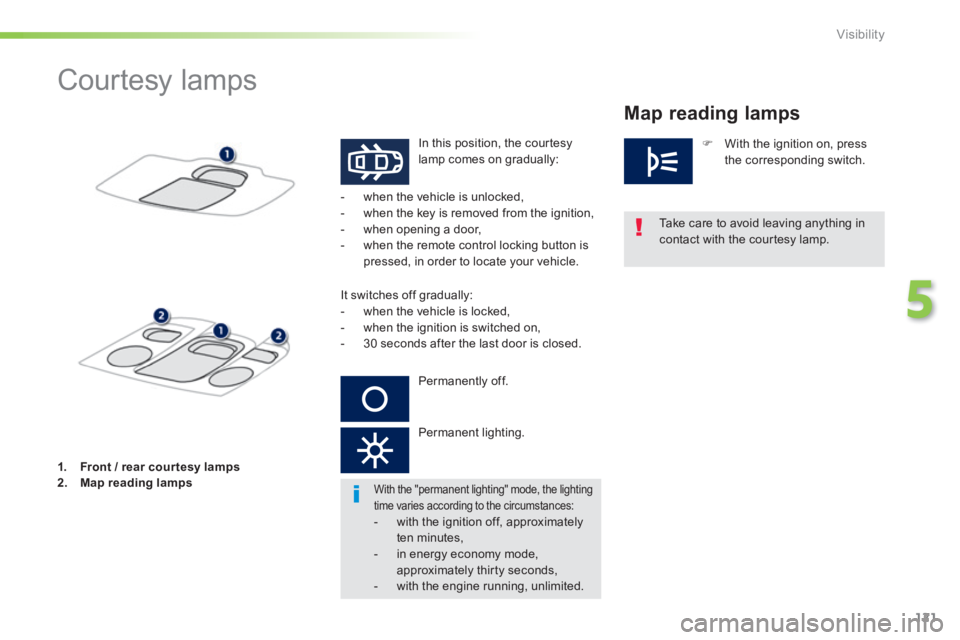
121
5
Visibility
Courtesy lamps
In this position, the courtesy lamp comes on gradually:
Take care to avoid leaving anything in
contact with the courtesy lamp.
- when the vehicle is unlocked, - when the key is removed from the ignition, - when opening a door, - when the remote control locking button is pressed, in order to locate your vehicle.
It switches off gradually: - when the vehicle is locked, - when the ignition is switched on, - 30 seconds after the last door is closed.
Permanently off.
Permanent lighting.
With the ignition on, press the corresponding switch.
1. Front / rear cour tesy lamps2. Map reading lamps With the "permanent lighting" mode, the lighting time varies according to the circumstances: - with the ignition off, approximately
ten minutes, - in energy economy mode, approximately thirty seconds, - with the engine running, unlimited.
Map reading lamps
Page 136 of 336
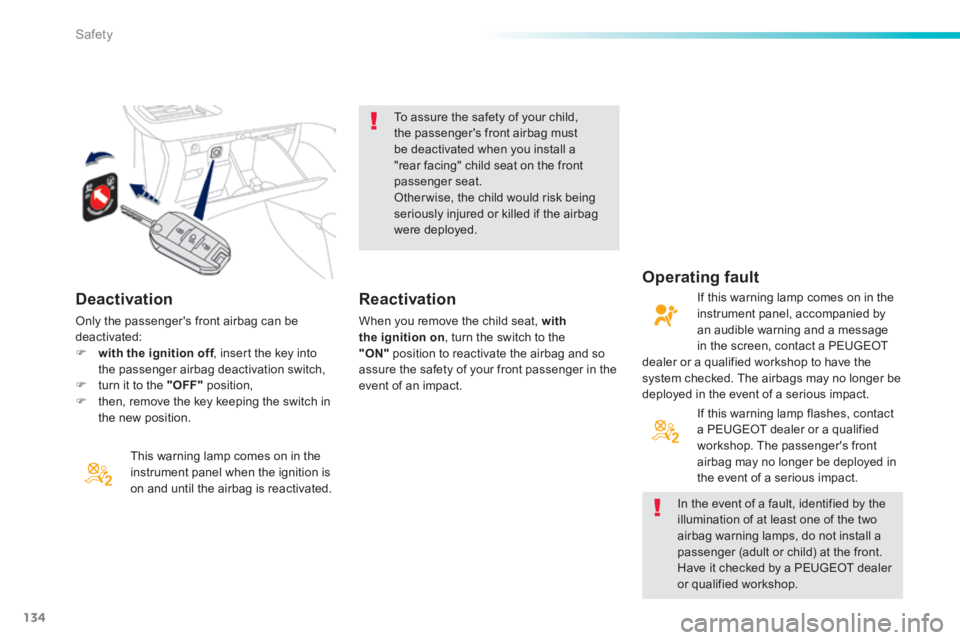
134
Safety
Deactivation
This warning lamp comes on in the instrument panel when the ignition is on and until the airbag is reactivated.
To assure the safety of your child, the passenger's front airbag must be deactivated when you install a "rear facing" child seat on the front passenger seat. Otherwise, the child would risk being seriously injured or killed if the airbag were deployed.
In the event of a fault, identified by the illumination of at least one of the two
airbag warning lamps, do not install a passenger (adult or child) at the front. Have it checked by a PEUGEOT dealer or qualified workshop.
Reactivation
When you remove the child seat, with the ignition on , turn the switch to the "ON" position to reactivate the airbag and so assure the safety of your front passenger in the event of an impact.
Operating fault
If this warning lamp comes on in the instrument panel, accompanied by an audible warning and a message in the screen, contact a PEUGEOT dealer or a qualified workshop to have the system checked. The airbags may no longer be deployed in the event of a serious impact.
If this warning lamp flashes, contact a PEUGEOT dealer or a qualified workshop. The passenger's front airbag may no longer be deployed in the event of a serious impact.
Only the passenger's front airbag can be deactivated: with the ignition off , insert the key into with the ignition off , insert the key into with the ignition offthe passenger airbag deactivation switch, turn it to the "OFF" position, then, remove the key keeping the switch in the new position.
Page 147 of 336
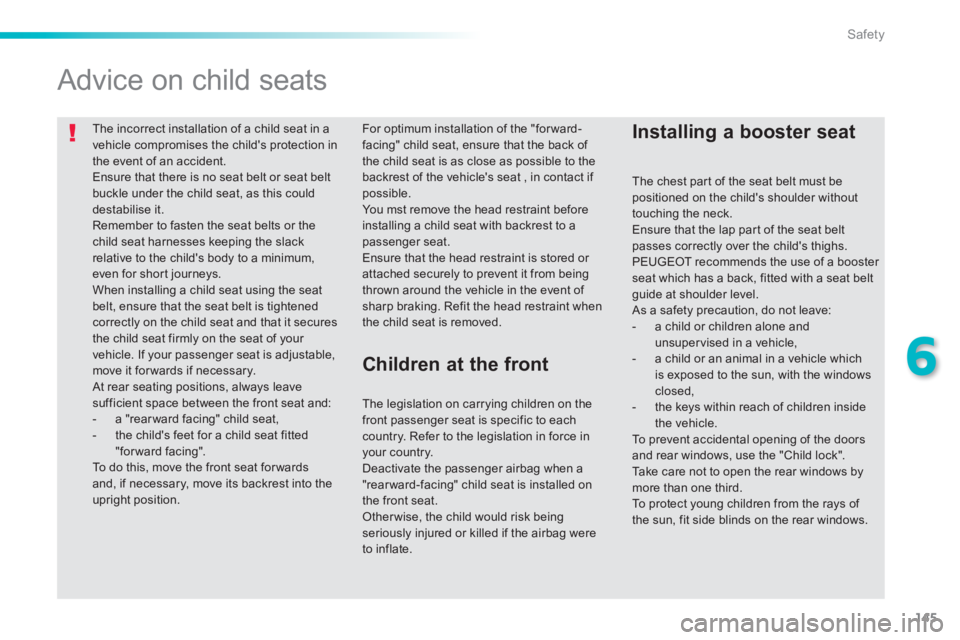
145
6
Safety
The incorrect installation of a child seat in a vehicle compromises the child's protection in the event of an accident. Ensure that there is no seat belt or seat belt buckle under the child seat, as this could destabilise it. Remember to fasten the seat belts or the child seat harnesses keeping the slack relative to the child's body to a minimum, even for short journeys. When installing a child seat using the seat belt, ensure that the seat belt is tightened correctly on the child seat and that it secures the child seat firmly on the seat of your vehicle. If your passenger seat is adjustable, move it for wards if necessary. At rear seating positions, always leave sufficient space between the front seat and: - a "rear ward facing" child seat,
- the child's feet for a child seat fitted "forward facing". To do this, move the front seat for wards and, if necessary, move its backrest into the upright position.
Advice on child seats
Installing a booster seat For optimum installation of the "forward-facing" child seat, ensure that the back of the child seat is as close as possible to the backrest of the vehicle's seat , in contact if possible. You mst remove the head restraint before installing a child seat with backrest to a passenger seat. Ensure that the head restraint is stored or attached securely to prevent it from being thrown around the vehicle in the event of sharp braking. Refit the head restraint when the child seat is removed.
Children at the front
The legislation on carrying children on the front passenger seat is specific to each country. Refer to the legislation in force in your country. Deactivate the passenger airbag when a "rear ward-facing" child seat is installed on the front seat. Otherwise, the child would risk being seriously injured or killed if the airbag were to inflate.
The chest part of the seat belt must be positioned on the child's shoulder without touching the neck. Ensure that the lap part of the seat belt passes correctly over the child's thighs. PEUGEOT recommends the use of a booster seat which has a back, fitted with a seat belt guide at shoulder level. As a safety precaution, do not leave: - a child or children alone and unsupervised in a vehicle, - a child or an animal in a vehicle which is exposed to the sun, with the windows closed, - the keys within reach of children inside the vehicle.
To prevent accidental opening of the doors and rear windows, use the "Child lock". Take care not to open the rear windows by more than one third. To protect young children from the rays of the sun, fit side blinds on the rear windows.
Page 152 of 336
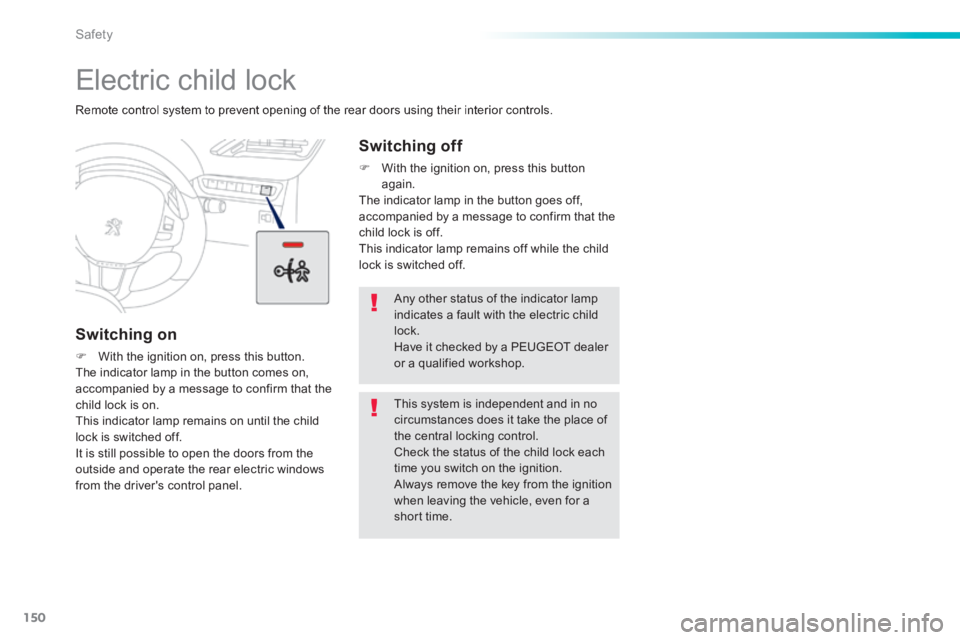
150
Safety
Electric child lock
Remote control system to prevent opening of the rear doors using their interior controls.
Switching on
With the ignition on, press this button. The indicator lamp in the button comes on, accompanied by a message to confirm that the child lock is on. This indicator lamp remains on until the child lock is switched off. It is still possible to open the doors from the outside and operate the rear electric windows from the driver's control panel.
Switching off
With the ignition on, press this button again. The indicator lamp in the button goes off, accompanied by a message to confirm that the child lock is off. This indicator lamp remains off while the child lock is switched off.
Any other status of the indicator lamp indicates a fault with the electric child lock. Have it checked by a PEUGEOT dealer or a qualified workshop.
This system is independent and in no circumstances does it take the place of the central locking control. Check the status of the child lock each time you switch on the ignition. Always remove the key from the ignition when leaving the vehicle, even for a short time.
Page 182 of 336
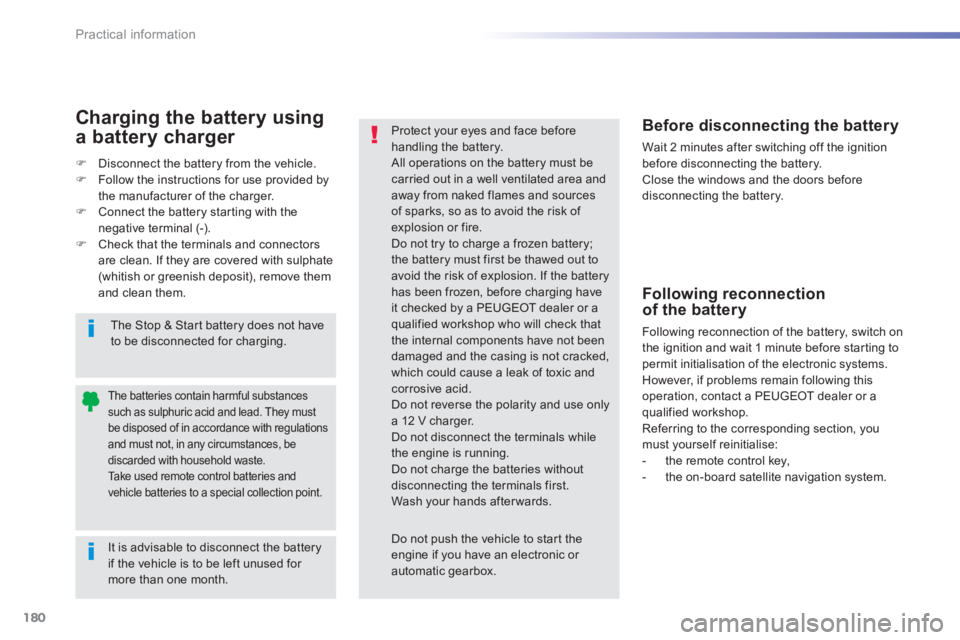
180
Practical information
It is advisable to disconnect the battery if the vehicle is to be left unused for more than one month.
The batteries contain harmful substances such as sulphuric acid and lead. They must be disposed of in accordance with regulations and must not, in any circumstances, be discarded with household waste. Take used remote control batteries and vehicle batteries to a special collection point.
Protect your eyes and face before handling the battery. All operations on the battery must be carried out in a well ventilated area and away from naked flames and sources of sparks, so as to avoid the risk of
explosion or fire. Do not try to charge a frozen battery; the battery must first be thawed out to avoid the risk of explosion. If the battery has been frozen, before charging have it checked by a PEUGEOT dealer or a qualified workshop who will check that the internal components have not been damaged and the casing is not cracked, which could cause a leak of toxic and corrosive acid. Do not reverse the polarity and use only a 12 V charger. Do not disconnect the terminals while the engine is running. Do not charge the batteries without disconnecting the terminals first. Wash your hands after wards.
Do not push the vehicle to start the engine if you have an electronic or automatic gearbox.
Before disconnecting the battery
Wait 2 minutes after switching off the ignition before disconnecting the battery. Close the windows and the doors before disconnecting the battery.
Following reconnection of the battery
Following reconnection of the battery, switch on the ignition and wait 1 minute before starting to permit initialisation of the electronic systems. However, if problems remain following this operation, contact a PEUGEOT dealer or a qualified workshop. Referring to the corresponding section, you must yourself reinitialise: - the remote control key, - the on-board satellite navigation system.
The Stop & Start battery does not have to be disconnected for charging.
Charging the battery using
a battery charger
Disconnect the battery from the vehicle. Follow the instructions for use provided by the manufacturer of the charger. Connect the battery starting with the negative terminal (-). Check that the terminals and connectors are clean. If they are covered with sulphate (whitish or greenish deposit), remove them and clean them.
Page 186 of 336
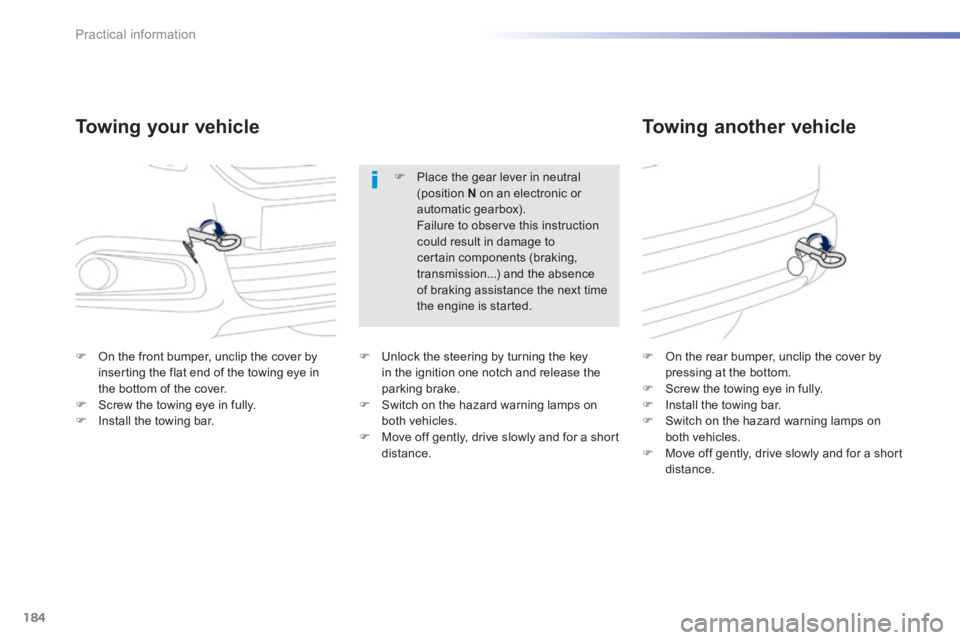
184
Practical information
Towing your vehicle Towing another vehicle
On the front bumper, unclip the cover by inserting the flat end of the towing eye in the bottom of the cover. Screw the towing eye in fully. Install the towing bar.
On the rear bumper, unclip the cover by pressing at the bottom. Screw the towing eye in fully. Install the towing bar. Switch on the hazard warning lamps on both vehicles. Move off gently, drive slowly and for a short distance.
Place the gear lever in neutral (position N on an electronic or automatic gearbox). Failure to observe this instruction could result in damage to certain components (braking, transmission...) and the absence of braking assistance the next time the engine is started.
Unlock the steering by turning the key in the ignition one notch and release the parking brake. Switch on the hazard warning lamps on both vehicles. Move off gently, drive slowly and for a short distance.
Page 196 of 336
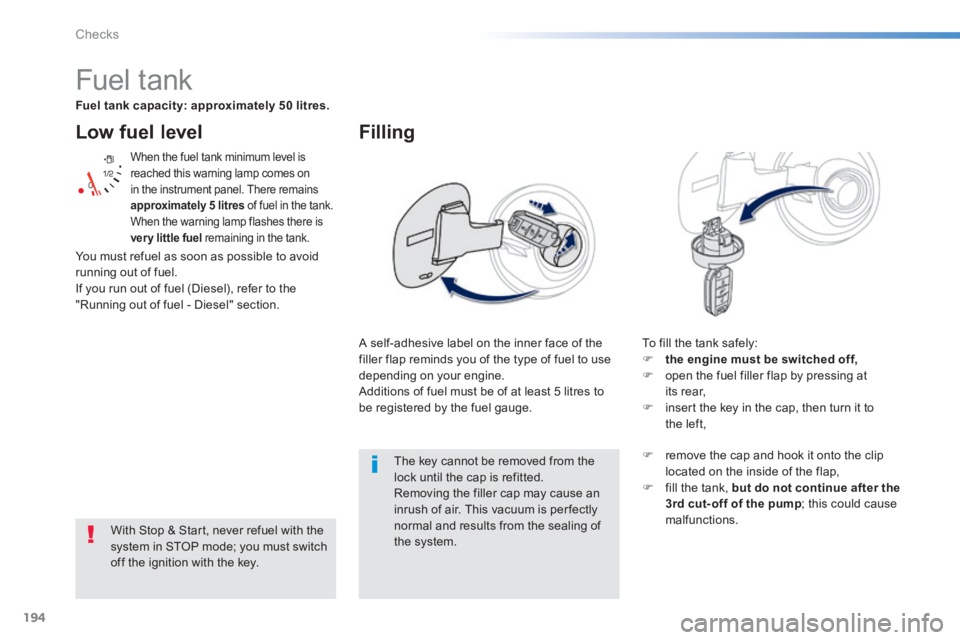
194
Checks
Low fuel level
When the fuel tank minimum level is reached this warning lamp comes on in the instrument panel. There remains approximately 5 litres of fuel in the tank. When the warning lamp flashes there is ver y little fuel remaining in the tank.
The key cannot be removed from the lock until the cap is refitted. Removing the filler cap may cause an inrush of air. This vacuum is per fectly normal and results from the sealing of the system.
Fuel tank
Fuel tank capacity: approximately 50 litres.
A self-adhesive label on the inner face of the filler flap reminds you of the type of fuel to use depending on your engine. Additions of fuel must be of at least 5 litres to be registered by the fuel gauge.
Filling
To fill the tank safely: the engine must be switched off, open the fuel filler flap by pressing at its rear, insert the key in the cap, then turn it to the left,
With Stop & Start, never refuel with the
system in STOP mode; you must switch off the ignition with the key.
remove the cap and hook it onto the clip located on the inside of the flap, fill the tank, but do not continue after the 3rd cut- off of the pump ; this could cause malfunctions.
You must refuel as soon as possible to avoid running out of fuel. If you run out of fuel (Diesel), refer to the "Running out of fuel - Diesel" section.
Page 197 of 336
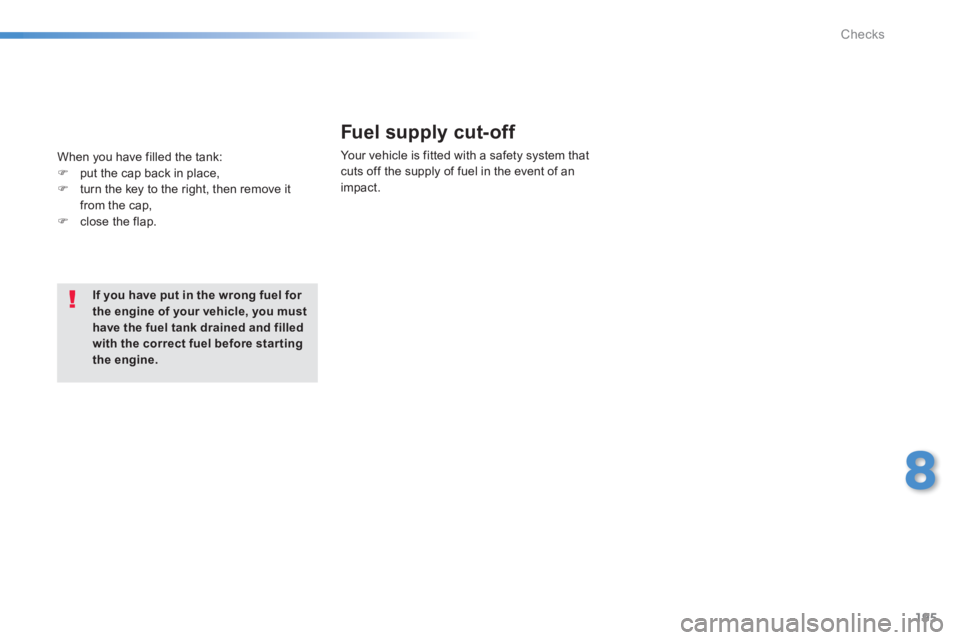
195
8
Checks
If you have put in the wrong fuel for the engine of your vehicle, you must have the fuel tank drained and filled with the correct fuel before star ting the engine.
Fuel supply cut-off
Your vehicle is fitted with a safety system that cuts off the supply of fuel in the event of an impact.
When you have filled the tank: put the cap back in place, turn the key to the right, then remove it from the cap, close the flap.